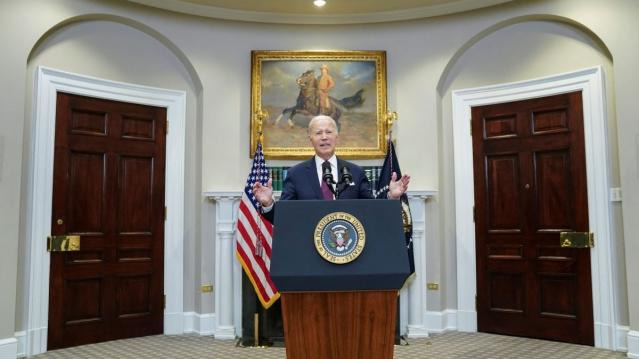Hope you’re having a good Thursday. Overturning nearly five decades of precedent, the Supreme Court ruled today that the use of racial considerations in college admissions is unconstitutional, prompting wildly different reactions across the political spectrum. President Biden slammed the decision, warning that “This is not a normal court,” while Education Secretary Miguel Cardona said the ruling is “yet another blow to the fight for equal opportunity” that “takes our country decades backward.” On the right, politicians celebrated the decision, with Senate Minority Leader Mitch McConnell denouncing what he called the “illegal social engineering” of affirmative action. “Today’s rulings make clear that colleges may not continue discriminating against bright and ambitious students based on the color of their skin,” he said.
Here’s what else is going on.
US Economy – and Biden – Get a Boost in New GDP Report
Revised figures from the Commerce Department show that the U.S. economy grew at a 2% annualized rate in the first three months of 2023, a significant increase from the initial estimate of 1.1%, though still a downshift from the 2.6% annualized growth rate recorded in the final quarter of 2022.
The third and final revision highlights “the surprising resilience of the country’s economic recovery, which has remained steady despite high inflation, rapidly rising interest rates and persistent predictions of a recession from many forecasters on Wall Street,” wrote Ben Casselman of The New York Times.
Speaking to reporters at an event in Washington, National Economic Council Director Lael Brainard said the numbers weaken the case for a recession, at least in the near term. “It’s hard not to conclude that the economy is resilient and chugging along and doing pretty well,” the former vice chair of the Federal Reserve said. “We want to see stable growth, we want to see sustainable growth, but the resilience has really been notable.”
Gregory Daco, chief economist at EY-Parthenon, said the report provides more support for the argument that the economy can slow down without crashing. “This is the immaculate soft-landing with below potential growth & easing inflation,” he tweeted.
In a separate report, initial jobless claims fell by 26,000 to 239,000 on a weekly basis, beating expectations and easing worries that the labor market was signaling a recession ahead. “Over the past couple of weeks the initial unemployment claims data had spiked, perhaps sending a worrying (albeit noisy) signal of a slowdown,” said University of Michigan economist Justin Wolfers. “Today’s good news: That spike has reversed. Maybe it was noise rather than signal.”
Taken together, the economic reports could boost President Joe Biden’s campaign to convince Americans that “Bidenomics” is a success. “This is going to be a tailwind for the economy,” said Joseph Brusuelas, chief economist at the consulting firm RSM, per Politico. “This is the stuff that’s going to increase productivity and bring down inflation” and “reflects the underlying resilience of the overall economy and the rock-solid foundation of U.S. households.”
Chart of the Day
Former Arkansas governor Asa Hutchinson is seen as a longshot for the Republican presidential nomination in 2024, but his proposal to reduce the size of the federal workforce may resonate with conservatives looking for ways to slash spending in the coming years. Just this week, Florida Gov. Ron DeSantis, the main challenger to frontrunner Donald Trump so far, said he would eliminate four federal agencies – Education, Commerce, Energy and the IRS – in a bid to “reduce the size and scope of government.” (Failing that, he said he said somewhat mysteriously that he would use those agencies to battle “woke ideology” and “leftism.”)
Hutchinson’s proposal to cut 10% of the federal workforce prompted the deficit hawks at the Committee for a Responsible Federal Budget to evaluate his plan. “We estimate this proposal could save the federal government as much as $350 billion over ten years if workers were laid off immediately, $150 billion if the policy was implemented through attrition of workers, and about $50 billion if exemptions were added to the policy,” CRFB concluded. The analysis includes this chart of the size of the federal workforce, which is estimated to cost about $4.5 trillion over the next 10 years, assuming no cuts are made.

Number of Preventable Deaths Soared During Pandemic – and Not Just Due to Covid-19
A growing number of Americans suffered preventable deaths between 2019 and 2021, according to a new analysis by the Commonwealth Fund, a nonpartisan health care research foundation.
Not surprisingly, the report finds that deaths from Covid-19 rose sharply during the first two years of the pandemic, but so too did deaths from drug overdoses, firearms, and some treatable chronic conditions including cancer and diabetes.
“Still reeling from the COVID-19 pandemic, states are trying to reverse a stunning rise in preventable deaths from multiple causes,” the report says. “These premature deaths have lowered the nation’s average life expectancy, with people of color experiencing the steepest declines.”
The sharpest increase in preventable deaths occurred in Arizona, Louisiana, Mississippi, New Mexico and Texas.
Overall state rankings: The report also ranks the states on the quality of their health care overall, based on 58 variables such as access and affordability; prevention and treatment; reproductive care and women’s health; income disparity; and racial equity. The top-rated state is Massachusetts, followed by Hawaii, New Hampshire, Rhode Island and Vermont. The lowest-rated state is Mississippi, followed by Oklahoma, West Virginia, Texas and Arkansas.
The report notes that seven of the 10 lowest-ranked states have not expanded their Medicaid programs as allowed by the Affordable Care Act. “Expanding their Medicaid programs would be the first step toward improving their health system performance,” Sara Collins, vice president of health care coverage and access at the Commonwealth Fund, told reporters, per USA Today.
Among its recommendations for improving health care outcomes, the report suggests expanding the primary care workforce, boosting addiction care, implementing longer Medicaid enrollment periods, and reducing the rate of growth of increase in health care costs.
Source: thefiscaltimes


